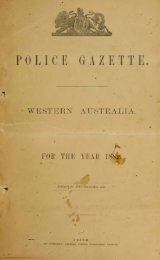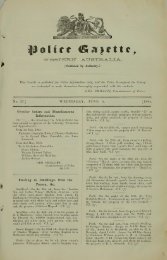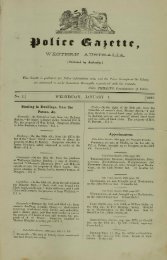Knowit Cover.qxd - State Library of Western Australia
Knowit Cover.qxd - State Library of Western Australia
Knowit Cover.qxd - State Library of Western Australia
Create successful ePaper yourself
Turn your PDF publications into a flip-book with our unique Google optimized e-Paper software.
a normal <strong>of</strong>fice and passed it around,<br />
not even using white gloves. This<br />
handling was possible because each<br />
papyrus had been 'sandwiched'<br />
between two taped pieces <strong>of</strong> Perspex,<br />
allowing space at the corners for airflow.<br />
In that housing they were able to treat<br />
these 2000+ years old artefacts just like<br />
paper. The archive comprised metal<br />
cabinets (similar to filing cabinets)<br />
filled with rows and rows <strong>of</strong> papyrus in<br />
Perspex.<br />
In the field <strong>of</strong> papyrology, the size and<br />
quality <strong>of</strong> the image available on the<br />
web depends on whether the papyrus<br />
• Stacks were organised by fixed<br />
location identifiers. At Heidelberg<br />
they were organised first by year,<br />
then size, then by running number.<br />
This scheme makes it much easier<br />
to allow for collection growth, as<br />
there is no need to estimate which<br />
subjects will grow and by how<br />
much. It also means that browsing<br />
is impossible and readers must rely<br />
on the catalogue.<br />
• Climate control: with the exception<br />
<strong>of</strong> the Herzog August Bibliothek<br />
archive in Wolfenbüttel, 'climate<br />
control' meant opening a window; in<br />
fact, one librarian at Göttingen<br />
age <strong>of</strong> the collections, with some dating<br />
back to old monastic collections (as in<br />
the case <strong>of</strong> the University <strong>of</strong> Leipzig)<br />
and are hundreds <strong>of</strong> years old. This is a<br />
different time scale to <strong>Australia</strong>n<br />
collections, so there is a different<br />
understanding <strong>of</strong> what is old, valuable<br />
or rare.<br />
Cultural programme<br />
The mission <strong>of</strong> the Goethe Institute<br />
includes encouraging and promoting<br />
German culture. Consequently, the<br />
group enjoyed a rich cultural<br />
programme, including German food and<br />
beverages, opera, art galleries and<br />
has already been published. If a<br />
papyrus has not been published, then<br />
only a thumbnail is available online; this<br />
enables this highly specialised field to<br />
control who is researching what to avoid<br />
duplication. Otherwise, a high quality<br />
digital image is freely available.<br />
Storage and collection<br />
organisation: the group had<br />
assumed that the collections would be<br />
stored and organised in similar ways to<br />
<strong>Australia</strong>n libraries, with some kind <strong>of</strong><br />
subject-based,<br />
international<br />
classification scheme in both open<br />
access and stack, books stored in air<br />
conditioning, rare books away from the<br />
public in controlled environmental<br />
conditions, and that stacks would<br />
largely consist <strong>of</strong> compactus. Most <strong>of</strong><br />
these assumptions were challenged.<br />
• All the libraries visited had open<br />
access items organised by subject,<br />
but using an in-house scheme.<br />
explained that many people believe<br />
that in Germany the books are<br />
better <strong>of</strong>f without air conditioning,<br />
especially because they do not<br />
experience the extremes <strong>of</strong> heat<br />
and humidity found in <strong>Australia</strong>.<br />
• Rare books storage: Göttingen has<br />
made the highly controversial<br />
decision to make their collection <strong>of</strong><br />
18th century monographs and<br />
serials publicly accessible in the<br />
original library, including all wooden<br />
shelves, open windows and no<br />
white gloves. The very rare books<br />
are kept in a separate area, but<br />
most are there to be browsed by<br />
anyone.<br />
• Compactus was a rarity, largely due<br />
to the fact that the libraries are in old<br />
buildings without the required floor<br />
ratings.<br />
Many <strong>of</strong> these differences to <strong>Australia</strong>n<br />
libraries have come about due to the<br />
visits to culturally significant venues,<br />
such as the Brandenburg Gate, Berlin<br />
Wall, the Gewandhaus in Leipzig and<br />
Heidelberg castle.<br />
Altogether the tour was an amazing<br />
experience and the group will keep in<br />
touch, sharing our common interest in<br />
digitisation. A joint report on the<br />
success <strong>of</strong> the study tour is being<br />
produced for the Goethe Institute and<br />
CASL.<br />
Grateful thanks are due to CASL for<br />
their help in organising the tour, to the<br />
Goethe Institute for providing a<br />
wonderful learning and cultural<br />
experience and to the <strong>State</strong> <strong>Library</strong> for<br />
allowing me participate.<br />
K<br />
Far left: Zeutschel Scanner, <strong>State</strong> <strong>Library</strong> <strong>of</strong><br />
Bavaria, Munich. Centre: Graz Cradles in use at<br />
the <strong>State</strong> <strong>Library</strong> <strong>of</strong> Bavaria and the University <strong>of</strong><br />
Heidelberg. Right: 18th Century book collection at<br />
the University <strong>of</strong> Göttingen<br />
KNOWIT. OCT - DEC 2005 11



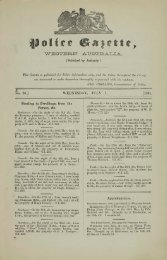
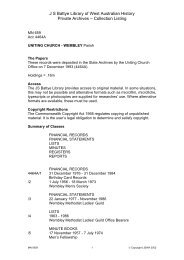
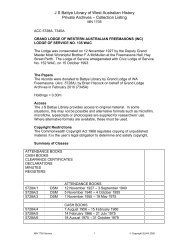
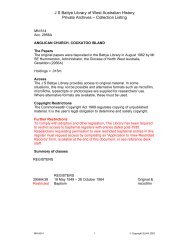

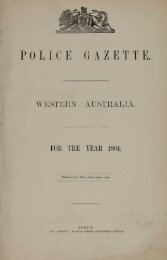

![No. 31.] WEDNESDAY, AUGUST 3. [1881. Stealing in Dwellings ...](https://img.yumpu.com/26317061/1/156x260/no-31-wednesday-august-3-1881-stealing-in-dwellings-.jpg?quality=85)
![No. 40.] WEDNESDAY, OCTOBER 5. [1887 Circular Orders and ...](https://img.yumpu.com/26317057/1/159x260/no-40-wednesday-october-5-1887-circular-orders-and-.jpg?quality=85)
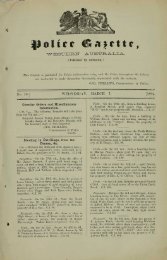
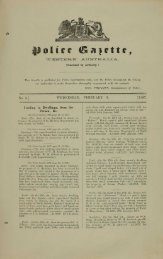
![No. 10.] WEDNESDAY, MARCH 5. [1884. Stealing- in Dwellings ...](https://img.yumpu.com/26317052/1/156x260/no-10-wednesday-march-5-1884-stealing-in-dwellings-.jpg?quality=85)
